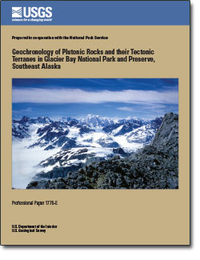Geochronology of plutonic rocks and their tectonic terranes in Glacier Bay National Park and Preserve, southeast Alaska
Links
- More information: USGS Index Page
- Document: Report
- Plate: Figure 1 (pdf)
- Larger Work: This publication is Chapter E of Studies by the U.S. Geological Survey in Alaska, 2008-2009
- Download citation as: RIS | Dublin Core
Abstract
We have identified six major belts and two nonbelt occurrences of plutonic rocks in Glacier Bay National Park and Preserve and characterized them on the basis of geologic mapping, igneous petrology, geochemistry, and isotopic dating. The six plutonic belts and two other occurrences are, from oldest to youngest: (1) Jurassic (201.6–145.5 Ma) diorite and gabbro of the Lituya belt; (2) Late Jurassic (161.0–145.5 Ma) leucotonalite in Johns Hopkins Inlet; (3) Early Cretaceous (145.5–99.6 Ma) granodiorite and tonalite of the Muir-Chichagof belt; (4) Paleocene tonalite in Johns Hopkins Inlet (65.5–55.8 Ma); (5) Eocene granodiorite of the Sanak-Baranof belt; (6) Eocene and Oligocene (55.8–23.0 Ma) granodiorite, quartz diorite, and granite of the Muir-Fairweather felsic-intermediate belt; (7) Eocene and Oligocene (55.8–23.0 Ma) layered gabbros of the Crillon-La Perouse mafic belt; and (8) Oligocene (33.9–23.0 Ma) quartz monzonite and quartz syenite of the Tkope belt. The rocks are further classified into 17 different combination age-compositional units; some younger belts are superimposed on older ones. Almost all these plutonic rocks are related to Cretaceous and Tertiary subduction events.
The six major plutonic belts intrude the three southeast Alaska geographic subregions in Glacier Bay National Park and Preserve, from west to east: (1) the Coastal Islands, (2) the Tarr Inlet Suture Zone (which contains the Border Ranges Fault Zone), and (3) the Central Alexander Archipelago. Each subregion includes rocks assigned to one or more tectonic terranes.
The various plutonic belts intrude different terranes in different subregions. In general, the Early Cretaceous plutons intrude rocks of the Alexander and Wrangellia terranes in the Central Alexander Archipelago subregion, and the Paleogene plutons intrude rocks of the Chugach, Alexander, and Wrangellia terranes in the Coastal Islands, Tarr Inlet Suture Zone, and Central Alexander Archipelago subregions.
Study Area
| Publication type | Report |
|---|---|
| Publication Subtype | USGS Numbered Series |
| Title | Geochronology of plutonic rocks and their tectonic terranes in Glacier Bay National Park and Preserve, southeast Alaska |
| Series title | Professional Paper |
| Series number | 1776 |
| Chapter | E |
| DOI | 10.3133/pp1776E |
| Year Published | 2014 |
| Language | English |
| Publisher | U.S. Geological Survey |
| Publisher location | Reston, VA |
| Contributing office(s) | Alaska Science Center |
| Description | Report: iv, 18 p.; 1 Plate: 17.0 x 11.0 inches |
| Larger Work Type | Report |
| Larger Work Subtype | USGS Numbered Series |
| Larger Work Title | Studies by the U.S. Geological Survey in Alaska, 2008-2009 (Professional Paper 1776) |
| Country | United States |
| State | Alaska |
| Other Geospatial | Central Alexander Archipelago, Glacier Bay National Park And Preserve, Johns Hopkins Inlet |
| Online Only (Y/N) | Y |
| Additional Online Files (Y/N) | Y |


